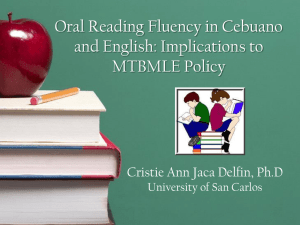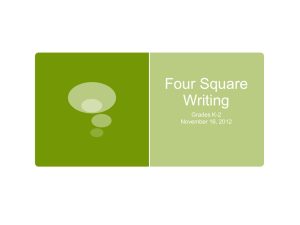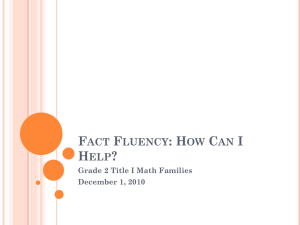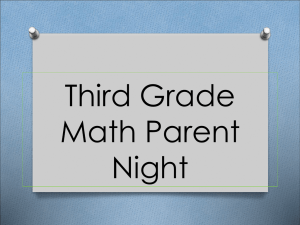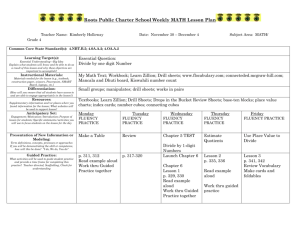Reading Aloud & Fluency: A Research Proposal
advertisement
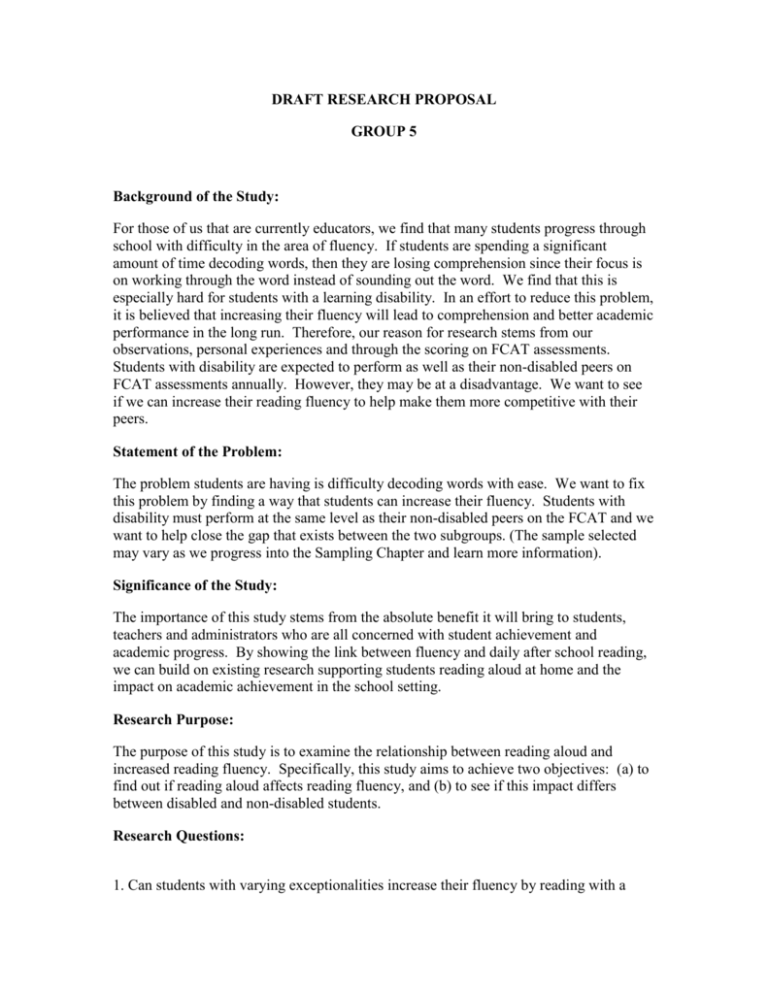
DRAFT RESEARCH PROPOSAL GROUP 5 Background of the Study: For those of us that are currently educators, we find that many students progress through school with difficulty in the area of fluency. If students are spending a significant amount of time decoding words, then they are losing comprehension since their focus is on working through the word instead of sounding out the word. We find that this is especially hard for students with a learning disability. In an effort to reduce this problem, it is believed that increasing their fluency will lead to comprehension and better academic performance in the long run. Therefore, our reason for research stems from our observations, personal experiences and through the scoring on FCAT assessments. Students with disability are expected to perform as well as their non-disabled peers on FCAT assessments annually. However, they may be at a disadvantage. We want to see if we can increase their reading fluency to help make them more competitive with their peers. Statement of the Problem: The problem students are having is difficulty decoding words with ease. We want to fix this problem by finding a way that students can increase their fluency. Students with disability must perform at the same level as their non-disabled peers on the FCAT and we want to help close the gap that exists between the two subgroups. (The sample selected may vary as we progress into the Sampling Chapter and learn more information). Significance of the Study: The importance of this study stems from the absolute benefit it will bring to students, teachers and administrators who are all concerned with student achievement and academic progress. By showing the link between fluency and daily after school reading, we can build on existing research supporting students reading aloud at home and the impact on academic achievement in the school setting. Research Purpose: The purpose of this study is to examine the relationship between reading aloud and increased reading fluency. Specifically, this study aims to achieve two objectives: (a) to find out if reading aloud affects reading fluency, and (b) to see if this impact differs between disabled and non-disabled students. Research Questions: 1. Can students with varying exceptionalities increase their fluency by reading with a peer tutor, parent or reading coach aloud five days a week in a before or after school setting under staff supervison? 2. How does the amount of time (0, 15, 20 minutes) spent reading aloud 5 days per week impact fluency? Statistical Hypothesis: Will reading aloud for either 0, 15 or 20 minutes nightly, 5 days a week significantly improve a student's fluency for students with a specific learning disability, including autism to a measurable and significant level? This is a DIRECTIONAL HYPOTHESIS. Variables: 1. Scores on similar/related, pre-selected FCAT passages (quantitative). 2. Rate of words correct per minute over time (continuous) 3. Time increments will be 0, 15, and 20 minutes based on which group the students are placed in (independent) 4. Specific Learning Disorder type or non-disabled students (dependent) 5. Frequency of time each night varies (manipulated) 6. SLD (controlled) Prediction: The more time that is spent reading, the fluency rate will increase. We predict that there would be a significant change in fluency rate from a student who reads 0 minutes to 20 minutes per night. We also might predict that a student who reads 15 minutes nightly would be closer to the student who read 20 minutes nightly. Which raises the question of: is the gap so close between reading 15 and 20 minutes, that students should just read 15 minutes per night and we have more success that they will do it. Literature Gaps: I found that there were several gaps in the literature surrounding our research question. Even though fluency has long been hailed as a necessary component to success in all academic areas, it seems as though there are very few studies that are focused on remediation in this area or activities in this area. Most reading programs explore other areas of interest and seem to exclude the best practices for increasing fluency. It would follow that reading aloud impacts fluency. Fluency is not an internal process, but one that involves reading out loud in an audible voice. While I found articles on reading aloud, I could not find any where reading aloud at home was linked to increased fluency. My main question stems from – what is the benefit of reading aloud nightly (as most educators ask their students to do) if there’s no one there to fix their mistakes? Will they actually benefit or will they be ingraining their reading mistakes further by not be corrected and simply allowed to continue making the mistake. The literature gap specifically related to this article and our research proposal is that specific data has not yet been identified or located to confirm that students with varying exceptionalities such as Autism, or specific learning disabilities will be able to sustain nightly readings or comprehend what they may be reading nightly. Additional research evaluations could be performed in these areas to determine the ability of these students to consistently remain focused and read nightly at the rates proposed in our research proposal. If the exceptionalities of these sample populations prevents a successful completion of the research it will be unclear if nightly readings can impact classroom fluency assessments for students with varying exceptionalities as identified. The literature gap related to this article and our research questions is that a changing criterion design was used in the study that involved contingent rewards. The results show that the student’s fluency improved overtime as long as the reward was present. The question is whether or not the student the student’s fluency problem had some behavioral relation. Our research proposal questions if student with disability, including those with Autism, are given the opportunity to read aloud with a peer, parent, or tutor for various period of times will this improve their fluency. Building on Previous Research: This research will document the impact of consistent nightly reading. In our research, we will be measuring students reading at varying amounts of time nightly and determining the impact on fluency rate. By reviewing our research results in conjunction with the cited research, hypothetical conclusions may be formulated to predict the potential impact of sustained nightly reading at timed intervals on the ability to read varying (higher and lower) reading passages in a classroom setting. In other words, as part of additional and separate research, we could see if there is a correlation between our sample students who read 20 minutes per night being able to more quickly reach and sustain the higher level reading passage that is tested in the classroom in the cited article. Also related, research has been done in order to find an instructional techniques that will improve teaching beginning reading. Studies have shown that fluency is a direct connection between decoding words and comprehension. Repeated reading is a strategy to increase fluency and strengthen areas of decoding and comprehension. Sampling: Our group of interest for our project includes students with Specific Learning Disabilities (SLD) and mild Autistic Spectrum Disorder (ASD). We are using the federal definition of SLD for the purposes of our research which is defined as follows: “Specific learning disability means a disorder in one or more of the basic psychological processes involved in understanding or in using language, spoken or written, that may manifest itself in an imperfect ability to listen, think, speak, read, write, spell, or to do mathematical calculations, including conditions such as perceptual disabilities, brain injury, minimal brain dysfunction, dyslexia, and developmental aphasia.” (34 C.F.R. §§300.7 and 300.541) Specifically, we are looking at a population of students who currently have an Individual Education Plan (IEP), are taught in either a self-contained ESE classroom or are mainstreamed, and have one of the following disorders: (1) Dysgraphia, (2) Dyslexia, (3) Dyspraxia, and (4) Auditory Processing Disorder. Research Problem to be investigated: The effects of reading aloud for 0, 15 or 20 minutes nightly, 5 days a week, on students with SLD/ASD as defined in our group of interest in the state of Florida. Target Population: Our target population includes ALL our group of interest in 3rd and 4th grade in the state of Florida. Accessible Population: All 3rd and 4th grade students as defined in our group of interest in all elementary schools in Orange County, FL. Sample Size: 10% of all 3rd and 4th grade students as defined in our group of interest in five elementary schools in Orange County, FL. Proposed Sampling Method: Since we are looking for a specific group of students, or specific subjects for the sample, we are conducting non-random sampling or purposive sampling. It is non-random or purposive because we are stipulating specific criteria that each student must have to be selected for our study. Not all students will have an equal chance of being chosen, and some have no chance of being selected. Only students that meet our criteria will be chosen for the study. We have decided to select a percentage of students from five of the elementary schools in Orange County because we believe that the more schools we use, the more likely the findings will be applicable on a larger scale and the more representative our study. Since we are conducting a study that is experimental, we need to look at approximately 30 students from each school Sampling Plan: 1. My intended sample (participants in my study) consists of (state who and how many): The intended sample consists of 10% of all 3rd and 4th grade students in five elementary schools in Orange County, FL. This is an experimental study and we need to identify approximately 30 students from each school. These students will currently have an Individual Education Plan (IEP), are taught in either a selfcontained ESE classroom or are mainstreamed, and have one of the following disorders: (1) Dysgraphia, (2) Dyslexia, (3) Dyspraxia, and (4) Auditory Processing Disorder. We are using the federal definition of SLD for the purposes of our research which is defined as follows: “Specific learning disability means a disorder in one or more of the basic psychological processes involved in understanding or in using language, spoken or written, that may manifest itself in an imperfect ability to listen, think, speak, read, write, spell, or to do mathematical calculations, including conditions such as perceptual disabilities, brain injury, minimal brain dysfunction, dyslexia, and developmental aphasia.” (34 C.F.R. §§300.7 and 300.541) 2. Key demographics (characteristics of the sample) are as follows (e.g., age range, sex, distribution, ethnic breakdown, socioeconomic status, location [where are these subjects located?], etc.): Here is a list of all the schools that we intend to use. They are all in Osceola County, FL. School # 1- Reedy Creek Elementary School 5100 Eagles Trail Kissimmee, FL 34758 Phone: 407-935-3580 / Fax: 407-935-3590 Principal: Diane Crook-Nichols nicholsd@osceola.k12.fl.us Age range: 5 thru 11 Grade range: KG thru 6th Sex distribution: female 52%, male: 48% Socioeconomic status: School is title 1 – more than 60% of the student population receives free or reduced lunch. Ethnic breakdown: White, Non-Hispanic 24.6%; Multicultural 4.0%; Hispanic 53.2%; Black, Non-Hispanic 13.4%; Asian or Pacific Islander 3.6%; American Indian or Alaskan 1.1% Total number of students enrolled in this school: 804 School # 2 - Pleasant Hill Elementary School 1253 Pleasant Hill Road Kissimmee, FL 34741 Phone: 407-935-3700 / Fax: 407-935-3705 Principal: Gary Bressler bressleg@osceola.k12.fl.us Age range: 4 thru 11 Grade range: Pre-K thru 5th Sex distribution: Female 53.1%, male 46.9% Socioeconomic status: 70.1% of students on free or reduced lunch – title 1 Ethnic breakdown: White, Non-Hispanic 27.4%; Multicultural 6.4%; Hispanic 52%; Black, Non-Hispanic 9.9%; Asian or Pacific Islander 3.7%; American Indian or Alaskan 0.6% Total # of students enrolled: 1010 School # 3 - Ventura Elementary School 275 Waters Edge Drive Kissimmee, FL 34743 Phone: 407-344-5040 / Fax: 407-344-5046 Principal: Janice Franceschi castroj@osceola.k12.fl.us Age Range: 5 thru 11 Grade Range: Kindergarten thru 5th Sex distribution: female 50.3%; male 49.7% Socioeconomic status: Title 1 – 60.8% of student population on free or reduced lunch. Ethnic breakdown: White, Non-Hispanic 7.8%; Multicultural 5.4%; Hispanic 76.2%; Black, Non-Hispanic 0.1%; Asian or Pacific Islander 1.4%; American Indian or Alaskan 0.4% Total # of students enrolled: 901 School # 4 - Central Avenue Elementary School 500 W. Columbia Avenue Kissimmee, FL 34741 Phone: 407-343-7330 / Fax: 407-343-7332 Principal: Rita Loeding loedingr@osceola.k12.fl.us Age Range: 5 thru 11 Grade Range: Kindergarten thru 5th Sex distribution: female 49.3%; male 50.7% Socioeconomic status: Title 1 – 50.1% on free or reduced lunch Ethnic breakdown: White, Non-Hispanic 8.8%; Multicultural 2.9%; Hispanic 65.7%; Black, Non-Hispanic 20.9%; Asian or Pacific Islander 1.5%; American Indian or Alaskan 0.3% Total # of students enrolled: 728 School # 5 - Boggy Creek Elementary School 810 Florida Parkway Kissimmee, FL 34743 Phone: 407-344-5060 / Fax: 407-344-5070 Principal: MaryAnn Rodriguez-Perez rodrigpm@osceola.k12.fl.us Age Range: 5 thru 11 Grade Range: Kindergarten thru 5th Sex distribution: female 47%; male 53% Socioeconomic status: Title 1 Ethnic breakdown: White, Non-Hispanic 7.5%; Multicultural 2.9%; Hispanic 77.5%; Black, Non-Hispanic 9.2%; Asian or Pacific Islander 1.8%; American Indian or Alaskan 1.0% Total # of students enrolled: 717 3. State what type of sample you plan to use (i.e., convenience, purposive, simple random, stratified random, cluster, systematic). Since we are looking for a specific group of students, or specific subjects for the sample, we are conducting non-random sampling or purposive sampling. It is non-random or purposive because we are stipulating specific criteria that each student must have to be selected for our study. Not all students will have an equal chance of being chosen, and some have no chance of being selected. Only students that meet our criteria will be chosen for the study. We have decided to select a percentage of students from five of the elementary schools in Osceola County because we believe that the more schools we use, the more likely the findings will be applicable on a larger scale and the more representative our study. Since we are conducting a study that is experimental, we need to look at approximately 30 students from each school. 4. I will gain access to and/or get contact information for my sample through the following steps: We will contact the Principal of each school and work collaboratively with administration, ESE department and general education teachers to get the information and students we need to conduct our research. We will make sure that student’s parents are informed and provide informed consent for their child to participate in our study. 5. What, if any, are the inclusion/exclusion criteria for participation in your study: The inclusion for my sample is based on the criteria as set forth in response #1 for the Sampling Plan. Only students who meet our required criteria will be considered. All others will be excluded since they are not of specific interest for this study. 6. External validity: a. To whom do you think you can generalize the results of your study: Explain. We can generalize the results of our study to any student in the United States in 3rd or 4th grade with a Specific Learning Disabilities (SLD) and mild Autistic Spectrum Disorder (ASD) ~ as previously defined. The results of our study can be generalized because we are using the non-random sampling method and purposive sampling for a target group of students. Even though our target is selected based on criteria, we are confident that it will be generalizable for all students with the select criteria since the schools we chose to work with were chosen randomly. This will guarantee that our sample has population generalizability and our target population is represented. b. If applicable, to what settings/conditions could you generalize the results of your study (ecological validity)? Our study could be generalized across different settings such as in the classroom, library, and at home. The study cannot be generalized according to subject because the study solely focuses on improving fluency in reading out loud. c. If results are not generalizable, why not? N/A Instrumentation Plan: 1. Describe the types of instrument(s) you plan to use for your study (e.g., interview protocol, attitudinal survey, achievement test, observation scale, questionnaire, focus group protocol, etc.). Instrument #1: DIBELS (Dynamic Indicators of Basic Early Literacy Skills) Author: Center on Teaching and Learning Availability: Center for Teaching and Learning, 5292 University of Oregon, Eugene, OR 97403 Website: https://dibels.uoregon.edu/ Year: 2002 The DIBELS assessment measures students in the 5 Big Ideas of Reading: 1. Phonemic Awareness is measured by Initial Sounds Fluency (ISF) and Phoneme Sound Fluency (PSF) 2. Alphabetic Principle is measured by Nonsense Word Fluency (NWF) 3. Accuracy & Fluency with connected text is measure by Oral Reading Fluency (ORF) ~ This is probably the one we are most interested in. This fluency assessment tool is intended for use in Kindergarten through 6th grade. Therefore, it will cover our sample for our research proposal for grades 3 & 4. Furthermore, it is recommended for use with SLD/ASD students as well as ELL. Since our population of students are SLD (as previously defined in our sample section) and mild ASD, we feel confident that this assessment tool can be used to measure their improvements in oral reading fluency. Students will be tested before, during and after the experiment process. This test can be administered by the classroom teacher and/or the reading specialist and data can be analyzed by the researcher. The person giving the test MUST be trained to administer the DIBELS assessment. Training can be done in multiple ways). Progress monitoring can be done weekly or monthly. If it is done weekly, then we need to use just one passage. If we do it monthly, then 2-3 passages need to be chosen and results need to be recorded accordingly. If done monthly, the scores of the multiple passages will be averaged giving a more accurate reflection of the student’s performance. Students are timed when reading each passage and their words correct in that minute are recorded. Testing will be done in the classroom, in the morning so the students are not tired. Testing will occur at the same time every week in the same location. This location must be quiet and free of distractions for either the student or the administrator of the assessment. Our concern is primarily with fluency, so that is what we are testing. We are not interested in DIBELS ability to assess comprehension. All details of how to administer the assessment will be taken from DIBELS. Passages are not repeated. Oral reading fluency scores will be collected, recorded and graphed accordingly to show progress (or lack thereof) over time. Citation for DIBELS: Good, R.H., & Kaminski, R.A. (Eds.). (2002). Dynamic indicators of basic early literacy skills (6th ed.). Eugene, OR: Institute for the Development of Educational Achievement. Available: http://dibels.uoregon.edu/ Instrument #2: Reading Fluency Indicator (RFI) Call Number: TC022950, Author: Kathleen T. Williams, Availability: AGS Publishing, 4201 Woodland Road, Circle Pines, Minnesota Website: www.speechandlanguage.com Year: 2004 Code: 2005/05 The Reading Fluency Indicator (RFI) measures oral reading rates, accuracy, and comprehension skills for students from Pre-Primer level to High School readers. This would include 3rd and 4th graders included in our sample. This tool may be used as a screening and monitoring tool and results may be used to help place students in instructional groups and guide in developing fluency goals for student IEP’s. 10 reading levels are included in the standard instrument. Our study will use a modified version of the RFI. The RFI will be administered individually to each student and allotted up to 10 minutes. Time will be doubled up to 20 minutes to allow for double time for accommodations as needed. The modified instrument will include 5 reading levels with 2 passages per level as selected from the RFI. These levels will include on grade level reading for 3rd and 4th grade each, plus two grade levels below 3rd and one level above 4th as identified in the RFI. The instrument will be limited to testing for fluency and not include comprehension skills as does the RFI. The Passage Booklet, Progress Record Form, and Manual of Procedures from the RFI will be used. Scoring, error analysis, and evaluation will follow the guidelines established in the RFI Manual of Procedures. Each student will have a Progress Record Form where fluency rates along with amount of time spent reading aloud per week will be recorded. Data will then be summarized for each student from the Progress Record Form and graphed to determine the correlation between reading aloud and fluency rates. All detail procedures will be taken from the actual RFI Instrument and applied to our sample population. The Instrument will be used in the before or after school program where the students will be under supervised reading periods. It is individually administered and takes 5-10 minutes to administer. It may be used as a screening and monitoring tool. Miscue analysis and optional prosody rating are included. It may also be used as a supplement to the Group Reading Assessment and Diagnostic Evaluation (TC022008-TC022018). Results may be used to help place students in appropriate instructional groups and may aid special education teachers in developing appropriate fluency goals for IEPs. Norms are provided. Administration: Screener Paper/Pencil 5-10 Minutes Test Setting: Individual Scores: Total Reading Time, Stanines, Quartile, WCPM, Miscue Analysis, Prosody Rating Publication Date: 2004 Ages / Grades: 1-12 Norms: Norm-Referenced Criterion-Referenced Forms: 10 Levels with four passages and four comprehension questions each How: Both instruments can be used as both an initial screening tool and a monitoring tool to assess fluency. The screener/classroom teacher/reading coach will administer the test multiple times over the duration of the experiment. The test provides 10 reading levels to choose from with 4 passages and comprehension questions. The test measures oral reading rates and accuracy and is norm and criterion referenced. Who: The screener who administers the test should be the teacher the student reads with after school or a counselor from the school. When: Both should be given before the intervention, halfway through the experiment, and as a final assessment. Where: The classroom after school 2. Is it a preexisting instrument or one you plan to develop? Both instruments are pre-existing instruments. We do not plan on developing any of our own instruments for use. 3. If preexisting, state the name of the instrument. Also, why did you decide to use this particular instrument? The RFI and DIBELS instruments are both research based and have been developed by knowledgeable people in the field with the expertise to create such an instrument. We chose each of these instruments based on our knowledge of them, based on the fact that both are used routinely in Florida schools exemplifying their validity and reliability. Both instruments will assess exactly what we are interested in finding out – they are both designed to test a student’s oral reading fluency. There is no need to modify them to get the results that we are looking for since both will provide exactly what we need. 4. What is the instrument supposed to measure or assess? The instrument is supposed to measure Oral Reading Fluency. 5. How many items will the instrument contain? The instrument will be given in strict accordance with the regulations as set forth by the product instructions to maintain its reliability and validity. Therefore, the number of items that the instrument will contain are based on the grade level (3rd or 4th of the student.) Passages will be selected as required and timing will be administered as outlined for the RFI test. As for the DIBELS test, we will test Oral Reading Fluency, Nonsense Word Fluency, Initial Sounds Fluency and Phoneme Sound Fluency. A predetermined number of words will be provided and students will have one minute to decode words accordingly. 6. How will the instrument be scored or interpreted? Each of the instruments have detailed graphs that will be used to plot student’s responses and score data. We will then interpret the scores accordingly. In short, students will have to read a selected passage or list of words in a certain amount of time and will be scored based on the number of words they correctly identified. References Submitted by A. Prince Kubina, R., Amato, J., Schwilk, C. L., & Therrien, W. J. (2008). Comparing Performance Standards on the Retention of Words Read Correctly per Minute. Journal of Behavioral Education, 17(4), 328-338. Retrieved from EBSCO host. References Submitted by D. Dillenseger: Bruns D, Pierce C. Let's Read Together: Tools for Early Literacy Development for All Young Children. Young Exceptional Children [serial online]. January 1, 2007;10(2):2-10. Available from: ERIC, Ipswich, MA. Accessed September 14, 2011. Marr, M., Algozzine, B., Nicholson, K., & Dugan, K. (2011). Building Oral Reading Fluency with Peer Coaching. Remedial and Special Education, 32(3), 256-264. Retrieved from EBSCOhost. References Submitted by C. Smith: Fienup, D. M., & Doepke, K. (2008). Evaluation of a Changing Criterion Intervention to Increase Fluent Responding with an Elementary Age Student with Autism. International Journal of Behavioral Consultation and Therapy, 4(3), 297-303. Retrieved from EBSCOhost. References Submitted by G. Mahon:



